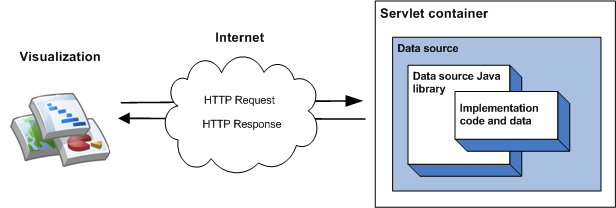Google の可視化データソース ライブラリを使用すると、可視化データソースを簡単に作成できます。このライブラリは、Google Visualization API のワイヤ プロトコルとクエリ言語を実装しています。データテーブルの形式でライブラリにデータを利用できるようにするために必要なコードを記述します。データテーブルは、すべての列が単一の型である 2 次元の値のテーブルです。抽象クラスとヘルパー関数を提供することで、必要なコードの記述が簡単になります。
ライブラリの最も簡単な実装は、単一のクラスから継承したり、メンバー関数を実装したり、データソースをサーブレット コンテナ内でサーブレットとして実行することです。最も簡単な実装では、ビジュアリゼーションがデータソースにクエリを実行すると、次の一連のイベントが発生します。
- サーブレット コンテナがクエリを処理し、そのクエリをデータソースの Java ライブラリに渡します。
- ライブラリはクエリを解析します。
- 実装コード(デベロッパーが記述するコード)は、データテーブルをライブラリに返します。
- このライブラリは、データテーブルに対してクエリを実行します。
- ライブラリは、可視化によって想定されるレスポンスにデータテーブルをレンダリングします。
- サーブレット コンテナはビジュアリゼーションへのレスポンスを返します。
これを次の図に示します。

このタイプのデータソースを実装する方法については、データソースのスタートガイドをご覧ください。
データソースによって提供されるデータは、実装コードで指定できます。これは、少量の静的データには問題ありません。データセットが大きい場合は、外部ファイルやデータベースなどの外部データストアを使用する必要がある可能性が高くなります。データソースが外部データストアを使用する場合、ビジュアリゼーションがデータソースにクエリを実行すると、次の一連のイベントが発生します。
- サーブレット コンテナがクエリを処理し、そのクエリをデータソースの Java ライブラリに渡します。
- ライブラリはクエリを解析します。
- 実装コード(デベロッパーが作成するコード)は、データストアに保持されているデータを読み取り、データテーブルをライブラリに返します。データセットが大きく、データストアにクエリの機能がある場合は、その機能を使用してデータソースの効率を向上させることができます。
- このライブラリは、データテーブルに対してクエリを実行します。
- ライブラリは、可視化によって想定されるレスポンスにデータテーブルをレンダリングします。
- サーブレット コンテナはビジュアリゼーションへのレスポンスを返します。
これを次の図に示します。

このタイプのデータソースを実装する方法については、外部データストアの使用セクションをご覧ください。
